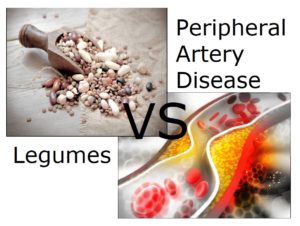
We looked at chickpeas and lentils yesterday, and discovered that, even when ground down into a powder and processed into different forms of pasta, they were still able to provide health benefits, specifically reducing postprandial blood glucose spikes compared with wheat pasta. But, what about legumes in general (beans, chickpeas, split peas and lentils) being able to reverse peripheral artery disease (PAD), also known as peripheral vascular disease (PVD)?
There’s loads of research showing that legumes are great for preventing/reducing:
- cholesterol levels 1
- excess body weight 2
- general inflammation 3
- insulin resistance 4
- oxidative stress 5
– all of these being major cardiovascular risk factors. So, it would make some sense if consuming them would also tackle PAD.
Blog Contents
What is PAD?
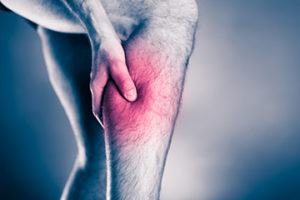
Peripheral artery disease (PAD) results from a decrease in blood flow to the limbs due to the presence of atherosclerotic plaque.
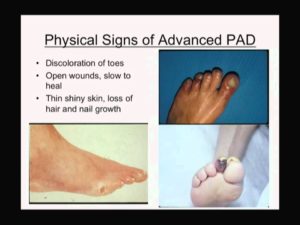
PAD affects around 20% of over-60’s 6 .
How do you test for it?
![]()
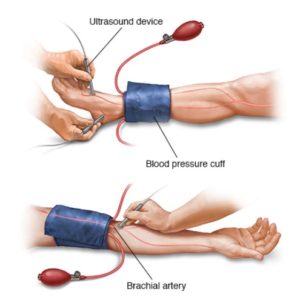
PAD diagnosis and progression are usually via ankle-brachial index (ABI), which is a ratio of systolic pressure at the ankle (posterior tibial or dorsalis pedis artery) and the arm (brachial artery). An ABI value below 0.9 indicates a reduction in the ankle blood pressure, due to the presence of arterial stenosis 7 which reduces blood flow to the legs 8 .
As a result, PAD is associated with a decrease in functional performance that will most likely diminish your quality of life 9 and represents an independent predictor of a high risk of death due to coronary artery and cerebrovascular disease 10 .
Pharmaceutical interventions have not proven particularly effective 11 , but epidemiological 12 evidence as well as interventional studies 13 have shown arterial stiffness may be improved through dietary change 14 15 .
What are the mechanisms involved?
It’s thought that the favourable results from studies 16 17 that show an association between a decreased incidence of atherosclerosis and increased consumption of legumes (both soy and non-soy) derive from a number of factors, including:
- a reduction in serum lipids due to the high fibre content and low glycaemic index of these legumes 18
- changes to arterial stiffness as a direct result of the action of the isoflavones 19 found in legumes 20
What does the research say?
A 2013 Canadian study 21 took twenty-six people with PAD and had them eat ½ cup a day of cooked legumes (beans, peas, lentils, chickpeas) each day for a period of 8 weeks.
They took baseline measurements at the start of the test and compared them with those taken after 8 weeks.
Study results
- overall, there was a positive response in terms of blood flow – the ankle-brachial index (ABI) showed a 5.5% increase
- four of the 26 participants were pushed up into the normal category – that is, a doctor would not be able to diagnose PAD in them if they were to see them for the first time and do an ABI test
- additionally, total and LDL-cholesterol were reduced by 5.0% and 8.7%, respectively
Study conclusions
The researchers concluded: “A legume-rich diet can elicit major improvements in arterial function and serum cholesterol in the absence of changes in either body mass or blood pressure…”
Additionally, the researchers concluded: “Although we provided significantly more legumes than is normally present in the standard North American diet, the amounts were both realistic and achievable, and were less than the single serving size recommended in the Canada Food Guide. Thus, obtaining positive changes in vascular function through dietary intervention is feasible.”
Final thoughts
Regarding the latter conclusion regarding daily servings, in his Daily Dozen 22 , Dr Greger recommends not only having one daily servings of legumes, but having them three times a day. This is probably the best way to get maximum cardiovascular protection from these wonderful yet unassuming dietary giants.
I try to get some into my breakfast muesli, into every salad and meal I eat during the day. They are also a useful quick snack to pull out of the fridge and mix with a little balsamic vinegar, black pepper and nutritional yeast. Yum!
Finally, on a personal note: my mother, whose diet was about as bad as you could imagine, had PAD, and the results of it were horrible to see. So, if you want to avoid or treat this and other blood-related diseases, it looks like legumes might be one of your best remedies. And remember, you have to actually consume them on a regular daily basis to get the best results – they don’t offer you the same protection when they’re sitting there in unopened jars or packets in your kitchen cupboard!
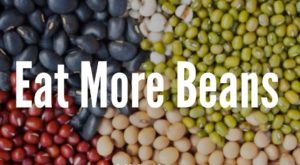
References
- Nutr Metab Cardiovasc Dis. Non-Soy Legume Consumption Lowers Cholesterol Levels: A Meta-Analysis of Randomized Controlled Trials. Lydia A. Bazzano, MD, PhD, Angela M. Thompson, MSPH, Michael T. Tees, MD, MPH, Cuong H. Nguyen, MPH, and Donna M. Winham, DrPH [↩]
- Clin Diabetes. 2015 Oct; 33(4): 198–205. Legumes: Health Benefits and Culinary Approaches to Increase Intake. Rani Polak, Edward M. Phillips, and Amy Campbell. [↩]
- J Nutr. 2012 Feb;142(2):334-9. doi: 10.3945/jn.111.146167. Epub 2011 Dec 21. Legume consumption is inversely associated with serum concentrations of adhesion molecules and inflammatory biomarkers among Iranian women. Esmaillzadeh A, Azadbakht L. [↩]
- Int J Prev Med. 2014 Jun; 5(6): 710–720. The Effects of Legumes on Metabolic Features, Insulin Resistance and Hepatic Function Tests in Women with Central Obesity: A Randomized Controlled Trial Mohammad Alizadeh, Rasool Gharaaghaji, Bahram Pourghassem Gargari. [↩]
- Eur J Clin Nutr. 2018 Jan;72(1):174-176. doi: 10.1038/ejcn.2017.113. Epub 2017 Jul 19. Therapeutic lifestyle change diet enriched in legumes reduces oxidative stress in overweight type 2 diabetic patients: a crossover randomised clinical trial. Mirmiran P, Hosseinpour-Niazi S, Azizi F. [↩]
- Mozaffarian D, Roger VL, Benjamin EJ, Berry JD, Borden WB, et al. Heart disease and stroke statisticse 2013 update: a report from the American Heart Association. Circulation 2013;127:e6e245. [↩]
- Wikipedia definition: Carotid artery stenosis. [↩]
- Dachun X, Jue L, Liling Z, Yawei X, Dayi H, Pagoto SL, et al. Sensitivity and specificity of the ankleebrachial index to diagnose peripheral artery disease: a structured review. Vasc Med 2010;15:361e9. [↩]
- Coutinho T, Rooke TW, Kullo IJ. Arterial dysfunction and functional performance in patients with peripheral artery disease: a review. Vasc Med 2011;16:203e11. [↩]
- Ankle Brachial Index Collaboration, Fowkes FG, Murray GD, Butcher I,
Heald CL, Lee RJ, et al. Ankle brachial index combined with Framingham Risk Score to predict cardiovascular events and mortality: a meta-analysis. J Am Med Assoc 2008;300:197e208. [↩] - Weber T, Auer J, Eisserer G, Berent R, Eber B, O’Rourke MF. Arterial stiffness and cardiovascular drugs. Curr Pharm Des 2003;9:1049e63. [↩]
- Wikipedia definition of epidemiology. [↩]
- EUPATI Definition of Interventional Studies. [↩]
- Bradley U, Spence M, Courtney CH, McKinley MC, Ennis CN, McCance DR, et al. Low-fat versus low-carbohydrate weight reduction diets: effects on weight loss, insulin resistance, and cardiovascular risk: a randomized control trial. Diabetes 2009;58:2741e8. [↩]
- Kesse-Guyot E, Vergnaud AC, Fezeu L, Zureik M, Blacher J, Peneau S, et al. Associations between dietary patterns and arterial stiffness, carotid artery intima-media thickness and atherosclerosis. Eur J Cardiovasc Prev Rehabil 2010;17:718e24. [↩]
- Kushi LH, Meyer KA, Jacobs Jr DR. Cereals, legumes, and chronic disease risk reduction: evidence from epidemiologic studies. Am J Clin Nutr 1999;70: 451Se8S. [↩]
- Yamori Y. Worldwide epidemic of obesity: hope for Japanese diets. Clin Exp Pharmacol Physiol 2004;31(Suppl. 2):S2e4. [↩]
- Anderson JW, Major AW. Pulses and lipaemia, short- and long-term effect: potential in the prevention of cardiovascular disease. Br J Nutr 2002;88(Suppl. 3):S263e71. [↩]
- What are Isoflavones? [↩]
- Nestel P. Isoflavones: their effects on cardiovascular risk and functions. Curr Opin Lipidol 2003;14:3e8. [↩]
- Zahradka P, Wright B, Weighell W, et al. Daily non-soy legume consumption reverses vascular impairment due to peripheral artery disease. Atherosclerosis. 2013;230(2):310-4. [↩]
- Daily Dozen Challenge [↩]